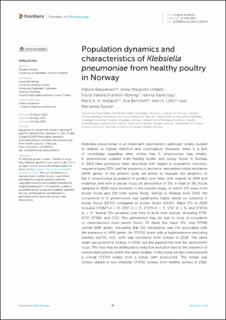| dc.description.abstract | Klebsiella pneumoniae is an important opportunistic pathogen widely studied in relation to human infection and colonization. However, there is a lack of knowledge regarding other niches that K. pneumoniae may inhabit. K. pneumoniae isolated from healthy broiler and turkey flocks in Norway in 2018 have previously been described with regard to population structure, sequence types (STs), and the presence of virulence- and antimicrobial resistance (AMR) genes. In the present study we aimed to evaluate the dynamics of the K. pneumoniae population in poultry over time, with regards to AMR and virulence, and with a special focus on persistence of STs. A total of 391 flocks sampled in 2020 were included in the present study, of which 271 were from broiler flocks and 120 from turkey flocks. Similar to findings from 2018, the occurrence of K. pneumoniae was significantly higher based on culturing in turkey flocks (62.5%) compared to broiler flocks (24.0%). Major STs in 2020 included ST5827 (n = 7), ST37 (n = 7), ST370 (n = 7), ST17 (n = 5), and ST4710 (n = 5). Several STs persisted over time in both host species, including ST35, ST37, ST590, and ST17. This persistence may be due to local re-circulation or reintroduction from parent flocks. Of these five major STs, only ST590 carried AMR genes, indicating that the persistence was not associated with the presence of AMR genes. An ST4710 strain with a hypervirulence-encoding plasmid (p4710; iro5, iuc5) was recovered from turkeys in 2018. The same strain was present in turkeys in 2020, but the plasmid had lost the salmochelin locus. This loss may be attributed to reductive evolution due to the presence of several siderophores within the same isolates. In this study we also characterized a clinical ST4710 isolate from a turkey with airsacculitis. The isolate was closely related to two intestinal ST4710 isolates from healthy turkeys in 2018. These three isolates were sampled within the same location and time frame in 2018, and all carried the full p4710 virulence plasmid. These findings highlight the transmission- and infectious potential of ST4710 in turkeys. | en_US |

